Bananas are known as one of the healthiest fruits globally, so they are popular. It is the second most significant fruit crop in India, after mango. Bananas are among the most sought-after fruits because of their affordability, nutritional value, taste, and medicinal properties. It is also an excellent choice for export. Bananas come in more than 300 different kinds across the globe. But in India, just 15 to 20 types are used most often in commercial production. Let’s check out the top varieties of Bananas in India below.
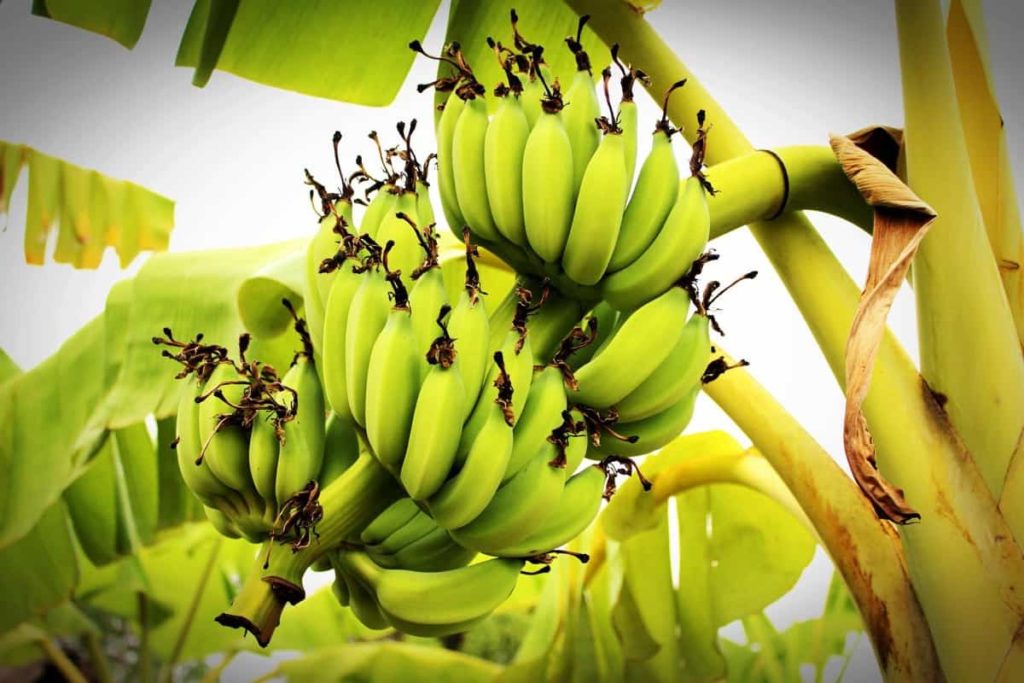
Among tropical and subtropical locations, bananas are the most common growing fruit. Since 2005, banana output in India has gradually increased. In 2006, India’s total banana output topped 20 million metric tons (MT). Banana output in India is rising at a fast pace each year. Bananas are grown mainly in the states of Tamil Nadu, Maharashtra, Andhra Pradesh, and Karnataka.
With a share of 16.27 percent, Andhra Pradesh is India’s leading banana producer. Banana production in Gujarat and Maharashtra ranks second and third in India, respectively. Each state has a 14% and a 13% stake, respectively. More than 1477 percent of bananas were grown in 2010-11 than in 2005-2006.
High yielding top varieties of Bananas in India
The Grand Naine
Musa acuminate, widely known as the Chiquita banana, is the parent species of giant Maine. The Cavendish banana variety is related to the Cavendish family. The fruit is part of the AAA genotype since it lacks seeds. India, Africa, Central America, and Southeast Asia are places where the plant is often found in gardens and orchards of this kind. This fruit is one of the critical economic drivers for all tropical nations.
With 8-10 hands and 200-220 fruits in each bunch, it can generate an average bunch weight of 25 kg. However, it can reach a bunch weight of 32-35 kg. The length of the fruit is between 15 and 21 cm, while its diameter is between 12 and 13 cm. The plant can withstand a wide range of weather conditions, including severe winds. A simple removal of the diseased leaves can help the plant develop further without restriction.
Robusta
Tamil Nadu and Karnataka portions are Robusta’s primary producers, a semi-tall kind of coffee. In India, Robusta bananas are a popular table variety. Large, well-developed fruit bunches are produced in abundance, and it has a high yield to match. The scent of the fruit is nice and sweet. Between 25 and 30 kilograms is the approximate weight of the bunch. Unfortunately, long-distance transport is not possible due to the fruit’s poor keeping quality, which causes the pulp to break down rapidly after ripening.
In case you missed it: Top 20 Steps to Boost Your Banana Fruit Yield: How to Increase Fruit Size, and Production
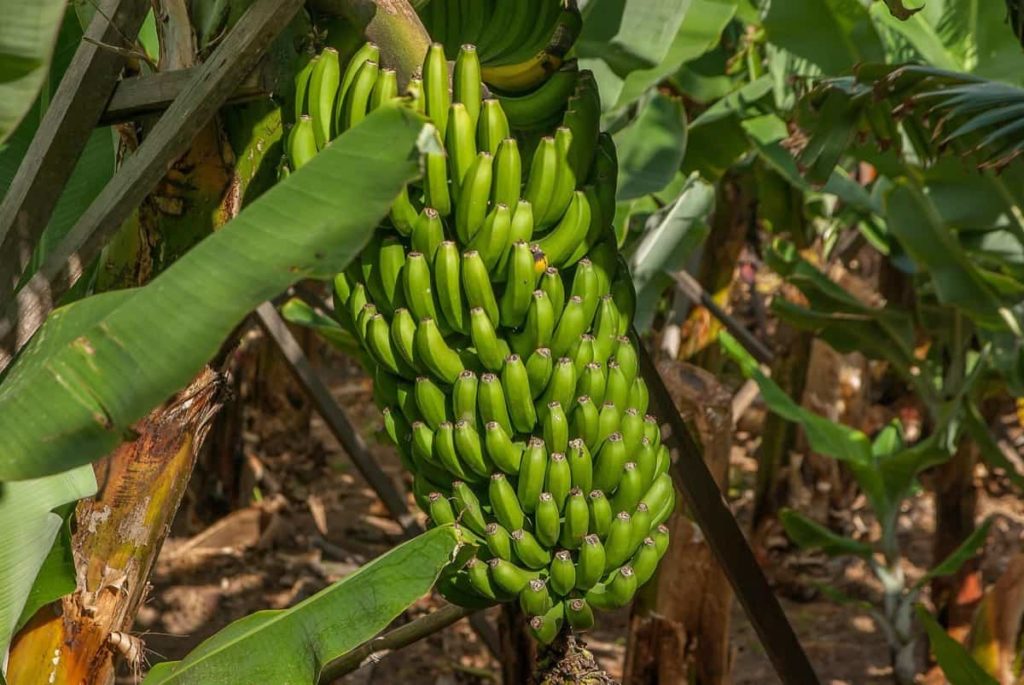
Dwarf cavendish
Dwarf Cavendish is the primary commercial type grown in Maharashtra, Bihar, Gujarat, and West Bengal for food and processing. Karnataka, Andhra Pradesh, and Tamil Nadu are some other states where it is grown. In Maharashtra, it’s one of the most popular banana kinds and is the most popular commercial variety all across India.
The fruit has a great appearance, but it will spoil quickly because of the poor quality of the bunch, length, and size. There are usually six to seven hands in a bunch that weighs 15 to 25 kg, and each hand has around 13 fruits. Fruits maintain some of their greenish colors even after they are fully ripe.
Dwarf plantain
The Puerto Rican Plantain Banana is another name for dwarf plantain. Plantain, a green raw banana, is the common name for this fruit. This plant yields many raw plantains, making it a high-yielding variety. You can use the plant’s easy-to-maintain characteristics to grow in your garden or inside. As a result, the plant is tolerant of temperature variations and droughts. The plantain tree can be found in the tropics up to six to eight feet tall. Fruits can grow to a size of 3 to 10 inches.
Red banana
The red banana is a well-known Indian banana with a thick reddish-purple peel. Red bananas are classified as Musa acuminate Colla under the Cavendish genus. The fruit has a good amount of heft to it. Bananas have a sweet and somewhat tart flavor when they are fully ripe when the flesh becomes a creamy to pinkish color. It’s a hardy plant that, with appropriate care, might yield bunches weighing 20-30 kg. Asia, South America, East Africa, and the United Arab Emirates are the most regularly farmed regions that sell to other nations.
Alpan (Poovan)
In Tamil Nadu, it’s known as Poovan, whereas in Andhra Pradesh, it’s known as Karpura Chakkarakeli, and in the northeast as Alpan. Perennial cultivation is the most common method of growing it. As a result of the state’s climatic and soil conditions, Tamil Nadu is the primary producer of the Poovan cultivar. Additionally, Poovan is grown commercially for its leaves in Tamil Nadu and specific areas of Kerala.
In case you missed it: Dwarf Banana Farming -Plantation In India
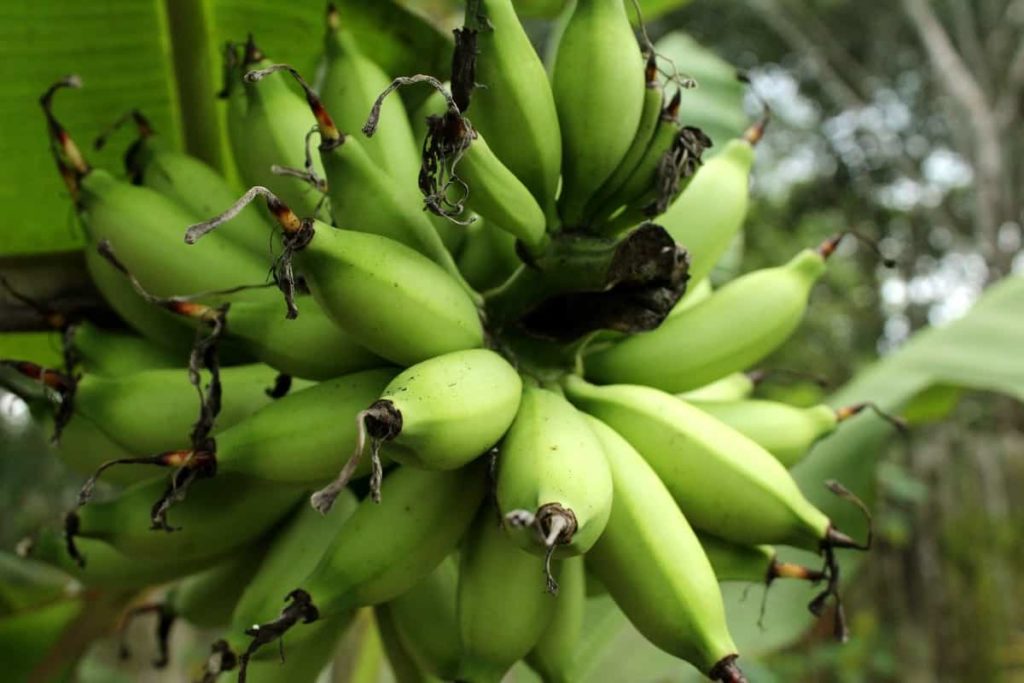
The fruit has a characteristic sour-sweet scent and is firm with a bit of acidity. On ripening, the fruit becomes a beautiful golden yellow color. In addition to the tight fruit packing and outstanding storage quality, this variety is also resistant to fruit breaking. Unfortunately, aside from BBMV disease and BSV, which cause significant yield losses, it is susceptible to banana bract mosaic (BBMV) disease and banana streak virus (BSV).
Nendran
In Kerala, Nendran is a popular kind of banana, and it’s grown in abundance. For both table and processing reasons, it’s an essential piece of equipment. Tamil Nadu has seen an explosion in the commercial cultivation of Nendran in recent years. Bunch’s five to six hands weigh anything from 12 to 15 kg. Fruits mature to a buff-yellow color and have a prominent neck with a thick layer of green skin.
Ney poovan
Commercial mono-cultivation of Ney Poovan in Karnataka and Tamil Nadu has made it one of the most popular diploid varieties. As a result, backyards and large-scale farming are becoming more common in Kerala. It is a thin plant that produces 15-30 kilograms of fruit after 12-14 months of growth. Despite their dark green color, these fruits have a high shelf life. The fruit has a strong aroma, a sweet flavor, and a powdered texture. Tolerant to leaf spot, yet vulnerable to Fusarium wilt and the banana bract mosaic virus, Ney Poovan is a hybrid variety.
Cavendish
Bananas of this variety can be found in nearly every grocery store or convenience store. The Cavendish banana tree produces a lot of large and fat fruits. Almost half of the banana crop is dedicated to making this fruit. Another term for this banana is “Common Banana,” which is also the name given to it by others.
In the decade after the 1950s, this particular kind of banana became well-known around the globe. Fruits of this plant can grow up to 15 to 25 cms. Most ideal weather can be found in tropical areas and places where it’s easy to grow food. Under these circumstances, it grows quickly and only requires a tiny amount of water.
In case you missed it: G9 Tissue Culture Banana Cultivation, Farming Practices
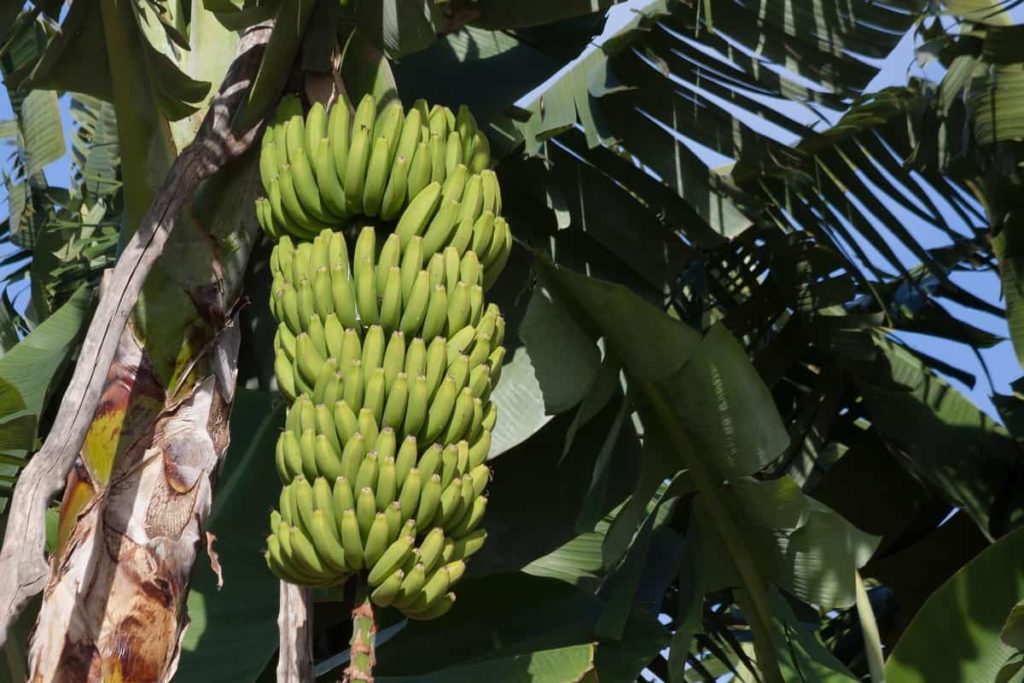
Safed Velchi Musa
The Thane and Nasik areas of Maharashtra are home to the cultivation of this fruit, which is regarded as high quality for eating. This kind is cultivated in the South Kanara regions of Karanataka. You can tell this variety apart by the reddish petiole border, big fruits with thin papery skin, and substantial white flesh that is tasty. It’s a medium-sized variety with a yellowish-green pseudostem and reddish petiole border. There are roughly 150 fruits in each bunch on average. The variety is available for approximately a year and a half.
Ice cream banana
The ice cream banana tree, another name for this cold-tolerant banana tree, is also known as the Blue Java and is grown in tropical regions such as the islands of Hawaii and Central America. Temperatures of 65 degrees Fahrenheit are ideal for the growth of this 15-foot-tall tree. To keep the water from evaporating, the soil has to be well-irrigated.
The fruit’s color ranges from blue to green. The banana has a medium size and a white, powdery feel within. Parents may easily offer their children this fruit since it tastes like vanilla. The amount of sunlight should be reduced by as much as 30%.
Monthan
It’s a common type for processing because of its broad cultivation spread. Monthan is a tall and sturdy plant that produces 18-20 kg of fruit in a year. Bold, thick, lumpy, and light green characterize the fruits. As a rule, the skin is green. However, there are two new ‘Monthan’ style clones that have lately become popular in Tamil Nadu: Kanchi Vazhai and Chakkia.
Besides being a delicious vegetable, pseudostem core has several medical benefits and culinary usage. Trichy and Tanjore districts of Tamil Nadu are also home to the cultivation of monthan for its leaves. If you’re looking for a banana resistant to BBTV and salt-tolerant, this one is a good choice. However, it’s susceptible to Fusarium wilt disease.
In case you missed it: Red Banana Farming, Cultivation, Planting Methods
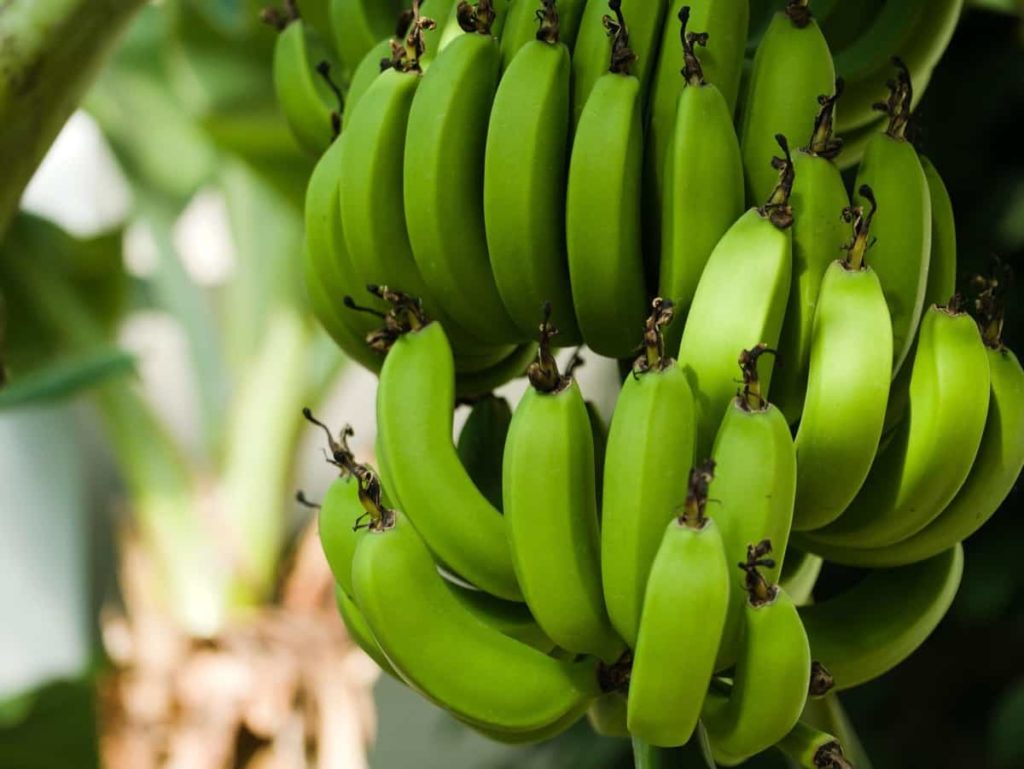
Karpuravalli
A popular cultivar known as Karpuravalli is cultivated for table use in medium-rich soils. It is grown mainly in the southern and central parts of Tamil Nadu and Kerala for commercial use. ‘Kanthali’ is the term given to the kind of farming practiced in Bihar. Karpuravalli is a tall, sturdy plant that grows well in marginal soils and requires little input to produce. Among Indian bananas, it has the best flavor and the most sweetness.
Karpuravalli can be seeded at various times, depending on the weather. Sweet and juicy bright yellow fruits with an ash coating are long-lasting. Karpuravalli is ideal for dry, salty, and low-input environments with its high vulnerability to wilt and tolerance to leaf spots.
Ladyfinger
In terms of size, Ladyfinger bananas or Rasakadali bananas have thin skin and a sweet flavor that makes them ideal for desserts. Bananas of this kind can reach a bunch weight of 10-14 hands and develop to a length of 4–5 inches with a light yellow color. There’s a thin layer of skin covering sweet flesh.
Vayal vazhai
A variety of bananas known as “Vayal Vazhai” is a relative of “Bluggoe.” The plants can reach 10 to 13 feet, have light pink leaves, and have flower stems that can reach several feet. It is native to Hawaii, Central America’s Cenizo region, and the West Indies. Bananas can grow to 7-9 inches and have a thickness of 2 inches.
Matti
The Matti pazham banana is another common variety in Tamil Nadu. Bananas of this kind are known to be among the most costly globally. Matti pazham is an oval-shaped fruit with a small fruit size.
In case you missed it: Organic Banana Farming, Cultivation Practices
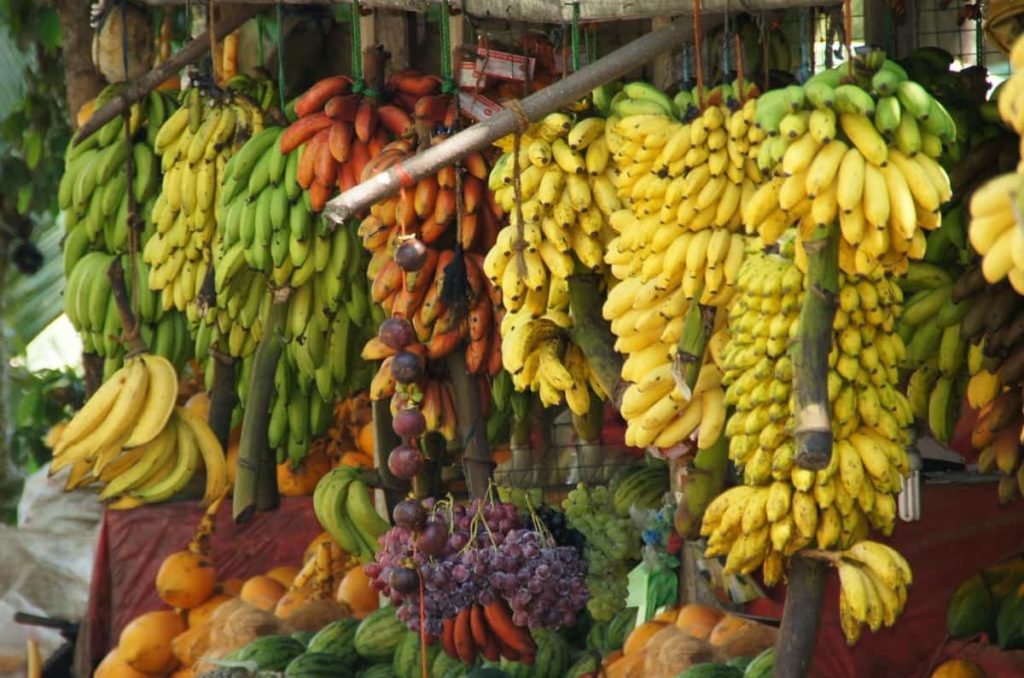
Sannachenkadali
A red banana-like appearance is produced using a red petiole and midrib. The bunch of Sannachenkadali is of medium size. Bananas of this kind are tiny, thin, and orange-yellow. From seed to harvest, this plant requires a full year.
Different banana varieties across India
| Andhra Pradesh | Dwarf Cavendish, Thella Chakrakeli, Karpoora Poovan, Chakrakeli, Robusta, Rasthali, Amritpant, Monthan and Yenagu Bontha |
| Tamil Nadu | Virupakshi,Monthan, Karpuravalli, Sakkai,Peyan,Matti, Robusta, Red Banana,Poovan,Rasthali,Nendran, |
| Kerala | Red Banana, Robusta, Palayankodan (Poovan), Nendran (Plantain), Rasthali, Monthan. |
| Assam | Jahaji (Dwarf Cavendish), Borjahaji (Robusta),Chini Champa, Bhimkol, Jatikol, Digjowa, Kulpait, Bharat Mon, Malbhog, Honda, Manjahaji, Chinia (Manohar), Kanchkol. |
| Gujarat | Gandevi Selection, G-9, Harichal, Shrimat, Harichal (Lokhandi), Dwarf Cavendish, Basrai, Robusta. |
| Karnataka | Robusta, Rasthali, Poovan, Monthan, Dwarf Cavendish, Elakki Bale. |
| Maharashtra | Basrai, Robusta, Safed Velchi, Rajeli Nendran, Lal Velchi, Grand Naine, Shreemanti, Red Banana, Dwarf Cavendish, Lal Velch. |
| West Bengal | Singapuri, Giant Governor, Mortman, Champa, Dwarf Cavendish, Kanthali. |
| Orissa | Robusta, Champa, DPatkapura (Rasthali), Dwarf Cavendish. |
| Bihar | Malbhig, Kothia, Gauria, Chinia, Muthia, Dwarf Cavendish, Alpon, Chini Champa. |
| Jharkhand | Basrai, Singapuri. |
- Economical Aquaculture: A Guide to Low-Budget Fish Farming
- 15 Common Planting Errors That Can Doom Your Fruit Trees
- How to Make Houseplants Bushy: Effective Tips and Ideas
- Innovative Strategies for Boosting Coconut Pollination and Yield
- Pollination Strategies for Maximum Pumpkin Yield
- The Complete Guide to Chicken Fattening: Strategies for Maximum Growth
- Natural Solutions for Tulip Problems: 100% Effective Remedies for Leaf and Bulb-Related Issues
- Revolutionizing Citrus Preservation: Towards a Healthier, Greener Future
- Natural Solutions for Peony Leaf and Flower Problems: 100% Effective Remedies
- Maximizing Profits with Avocado Contract Farming in India: A Comprehensive Guide
- Natural Solutions for Hydrangea Problems: 100% Effective Remedies for Leaf and Flowers
- The Ultimate Guide to Choosing the Perfect Foliage Friend: Bringing Life Indoors
- From Sunlight to Sustainability: 15 Ways to Use Solar Technology in Agriculture
- The Ultimate Guide to Dong Tao Chicken: Exploring from History to Raising
- The Eco-Friendly Makeover: How to Convert Your Unused Swimming Pool into a Fish Pond
- Mastering the Art of Delaware Chicken Farming: Essentials for Healthy Backyard Flocks
- 20 Best Homemade Fertilizers for Money Plant: DIY Recipes and Application Methods
- How to Craft a Comprehensive Free-Range Chicken Farming Business Plan
- Brighten Your Flock: Raising Easter Egger Chickens for Beauty and Bounty
- How to Optimize Your Poultry Egg Farm Business Plan with These Strategies
- Subsidy for Spirulina Cultivation: How Indian Government Schemes Encouraging Spirulina Farmers
- Ultimate Guide to Raising Dominique Chickens: Breeding, Feeding, Egg-Production, and Care
- Mastering the Art of Raising Jersey Giant Chickens: Care, Feeding, and More
- Ultimate Guide to Raising Legbar Chickens: Breeding, Farming Practices, Diet, Egg-Production
- How to Raise Welsummer Chickens: A Comprehensive Guide for Beginners
- How to Protect Indoor Plants in Winter: A Comprehensive Guide
- Ultimate Guide to Grow Bag Gardening: Tips, Tricks, and Planting Ideas for Urban Gardeners
- Guide to Lotus Cultivation: How to Propagate, Plant, Grow, Care, Cost, and Profit
- Agriculture Drone Subsidy Scheme: Government Kisan Subsidy, License, and How to Apply Online
- Ultimate Guide to Raising Araucana Chickens: Breed Profile, Farming Economics, Diet, and Care
- Bringing Hydroponics to Classroom: Importance, Benefits of Learning for School Students
- Ultimate Guide to Raising Polish Chickens: Breed Profile, Farming Economics, Diet, and Care
- Ultimate Guide to Raising Australorp Chickens: Profile, Farming Economics, Egg Production, Diet, and Care
- Silkie Chicken Farming: Raising Practices, Varieties, Egg Production, Diet, and Care
- Sussex Chicken Farming: Raising Practices, Varieties, Egg Production, Diet and Care
- Homemade Feed Formulations for Livestock: Discover Cost-effective Starter to Finisher Feed Recipes
Good information. Happy to learn about varieties of Banana grown in our country
Thank you or the information. its informative and i am happy to get these list .